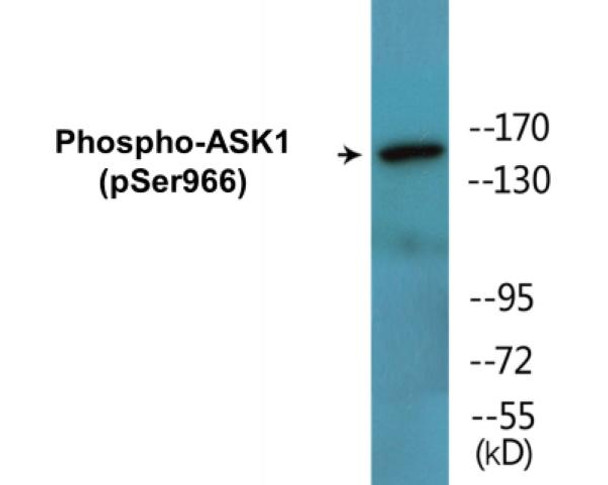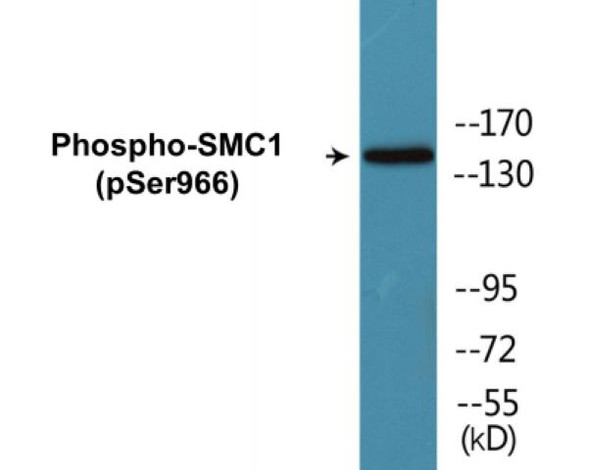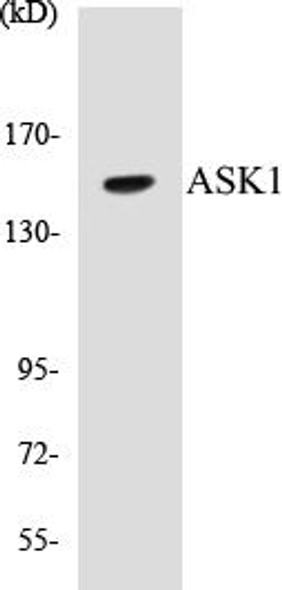Description
ASK1 (Phospho-Ser966)Colorimetric Cell-Based ELISA Kit
The Human Phospho-Ser966 ELISA Kit is specifically designed for the precise measurement of phospho-Ser966 levels in cell lysates and tissue homogenates. This kit offers a high level of sensitivity and specificity, ensuring accurate and reproducible results for a variety of research applications.Phospho-Ser966 is a key phosphorylation site involved in cellular signaling pathways, regulating essential processes such as cell growth, differentiation, and survival.
Dysregulation of this phosphorylation site has been implicated in various diseases, including cancer, diabetes, and neurological disorders, highlighting its importance as a potential therapeutic target.With the Human Phospho-Ser966 ELISA Kit, researchers can confidently study the role of phospho-Ser966 in disease development and progression, paving the way for the discovery of novel treatment strategies.
| Product Name: | ASK1 (Phospho-Ser966) Colorimetric Cell-Based ELISA |
| Product Code: | CBCAB00049 |
| ELISA Type: | Cell-Based |
| Target: | ASK1 (Phospho-Ser966) |
| Reactivity: | Human, Mouse, Rat |
| Dynamic Range: | > 5000 Cells |
| Detection Method: | Colorimetric 450 nm |
| Format: | 2 x 96-Well Microplates |
The ASK1 (Phospho-Ser966) Colorimetric Cell-Based ELISA Kit is a convenient, lysate-free, high throughput and sensitive assay kit that can detect ASK1 protein phosphorylation and expression profile in cells. The kit can be used for measuring the relative amounts of phosphorylated ASK1 in cultured cells as well as screening for the effects that various treatments, inhibitors (ie. siRNA or chemicals), or activators have on ASK1 phosphorylation.
Qualitative determination of ASK1 (Phospho-Ser966) concentration is achieved by an indirect ELISA format. In essence, ASK1 (Phospho-Ser966) is captured by ASK1 (Phospho-Ser966)-specific primary antibodies while the HRP-conjugated secondary antibodies bind the Fc region of the primary antibody. Through this binding, the HRP enzyme conjugated to the secondary antibody can catalyze a colorimetric reaction upon substrate addition. Due to the qualitative nature of the Cell-Based ELISA, multiple normalization methods are needed:
| 1. | A monoclonal antibody specific for human GAPDH is included to serve as an internal positive control in normalizing the target absorbance values. |
| 2. | Following the colorimetric measurement of HRP activity via substrate addition, the Crystal Violet whole-cell staining method may be used to determine cell density. After staining, the results can be analysed by normalizing the absorbance values to cell amounts, by which the plating difference can be adjusted. |
| Database Information: | Gene ID: 4217, UniProt ID: Q99683, OMIM: 602448, Unigene: Hs.186486 |
| Gene Symbol: | MAP3K5 |
| Sub Type: | Phospho |
| UniProt Protein Function: | ASK1: a MAP kinase kinase kinase of the STE11 family, apoptosis signal-regulating kinase 1 (ASK1) plays essential roles in stress-induced apoptosis. Activated by various stressors, including oxidative stress, endoplasmic reticulum stress, and calcium overload, as well as by receptor-mediated inflammatory signals, such as the tumor necrosis factor (TNF) and lipopolysaccharide (LPS). In turn, ASK1 phosphorylates and activates two different subgroups of MAP kinase kinases, MKK4/SEK1 and MKK3/MKK6, which in turn activate stress-activated protein kinases (JNKs) and p38 subgroups of MAP kinases, respectively. Overexpression activates JNK and p38 and induces apoptosis in several cell types through signals involving the mitochondrial cell death pathway. Embryonic fibroblasts or primary neurons derived from ASK1-/- mice are resistant to stress-induced JNK and p38 activation as well as cell death. Oxidative stress induces the activation of ASK1, which correlate with ASK1 activity and ASK1-dependent apoptosis. Required for the innate immune response, which is essential for host defense against a wide range of pathogens. |
| UniProt Protein Details: | Protein type:EC 2.7.11.25; Kinase, protein; Protein kinase, STE; Protein kinase, Ser/Thr (non-receptor); STE group; STE11 family Chromosomal Location of Human Ortholog: 6q23.3 Cellular Component: cytosol Molecular Function:ATP binding; magnesium ion binding; MAP kinase kinase kinase activity; protein binding; protein homodimerization activity; protein kinase activity; protein phosphatase binding; protein serine/threonine kinase activity Biological Process: activation of JNK activity; activation of MAPKK activity; induction of apoptosis by oxidative stress; JNK cascade; MAPKKK cascade; positive regulation of apoptosis; positive regulation of caspase activity; positive regulation of JNK activity; positive regulation of JNK cascade; protein amino acid phosphorylation |
| NCBI Summary: | Mitogen-activated protein kinase (MAPK) signaling cascades include MAPK or extracellular signal-regulated kinase (ERK), MAPK kinase (MKK or MEK), and MAPK kinase kinase (MAPKKK or MEKK). MAPKK kinase/MEKK phosphorylates and activates its downstream protein kinase, MAPK kinase/MEK, which in turn activates MAPK. The kinases of these signaling cascades are highly conserved, and homologs exist in yeast, Drosophila, and mammalian cells. MAPKKK5 contains 1,374 amino acids with all 11 kinase subdomains. Northern blot analysis shows that MAPKKK5 transcript is abundantly expressed in human heart and pancreas. The MAPKKK5 protein phosphorylates and activates MKK4 (aliases SERK1, MAPKK4) in vitro, and activates c-Jun N-terminal kinase (JNK)/stress-activated protein kinase (SAPK) during transient expression in COS and 293 cells; MAPKKK5 does not activate MAPK/ERK. [provided by RefSeq, Jul 2008] |
| UniProt Code: | Q99683 |
| NCBI GenInfo Identifier: | 6685617 |
| NCBI Gene ID: | 4217 |
| NCBI Accession: | Q99683.1 |
| UniProt Secondary Accession: | Q99683,Q5THN3, Q99461, A6NIA0, B4DGB2, |
| UniProt Related Accession: | Q99683 |
| Molecular Weight: | 69,839 Da |
| NCBI Full Name: | Mitogen-activated protein kinase kinase kinase 5 |
| NCBI Synonym Full Names: | mitogen-activated protein kinase kinase kinase 5 |
| NCBI Official Symbol: | MAP3K5 |
| NCBI Official Synonym Symbols: | ASK1; MEKK5; MAPKKK5 |
| NCBI Protein Information: | mitogen-activated protein kinase kinase kinase 5 |
| UniProt Protein Name: | Mitogen-activated protein kinase kinase kinase 5 |
| UniProt Synonym Protein Names: | Apoptosis signal-regulating kinase 1; ASK-1; MAPK/ERK kinase kinase 5; MEK kinase 5; MEKK 5 |
| Protein Family: | DASH complex |
| UniProt Gene Name: | MAP3K5 |
| Component | Quantity |
| 96-Well Cell Culture Clear-Bottom Microplate | 2 plates |
| 10X TBS | 24 mL |
| Quenching Buffer | 24 mL |
| Blocking Buffer | 50 mL |
| 15X Wash Buffer | 50 mL |
| Primary Antibody Diluent | 12 mL |
| 100x Anti-Phospho Target Antibody | 60 µL |
| 100x Anti-Target Antibody | 60 µL |
| Anti-GAPDH Antibody | 60 µL |
| HRP-Conjugated Anti-Rabbit IgG Antibody | 12 mL |
| HRP-Conjugated Anti-Mouse IgG Antibody | 12 mL |
| SDS Solution | 12 mL |
| Stop Solution | 24 mL |
| Ready-to-Use Substrate | 12 mL |
| Crystal Violet Solution | 12 mL |
| Adhesive Plate Seals | 2 seals |
The following materials and/or equipment are NOT provided in this kit but are necessary to successfully conduct the experiment:
- Microplate reader able to measure absorbance at 450 nm and/or 595 nm for Crystal Violet Cell Staining (Optional)
- Micropipettes with capability of measuring volumes ranging from 1 µL to 1 ml
- 37% formaldehyde (Sigma Cat# F-8775) or formaldehyde from other sources
- Squirt bottle, manifold dispenser, multichannel pipette reservoir or automated microplate washer
- Graph paper or computer software capable of generating or displaying logarithmic functions
- Absorbent papers or vacuum aspirator
- Test tubes or microfuge tubes capable of storing ≥1 ml
- Poly-L-Lysine (Sigma Cat# P4832 for suspension cells)
- Orbital shaker (optional)
- Deionized or sterile water
*Note: Protocols are specific to each batch/lot. For the correct instructions please follow the protocol included in your kit.
| Step | Procedure |
| 1. | Seed 200 µL of 20,000 adherent cells in culture medium in each well of a 96-well plate. The plates included in the kit are sterile and treated for cell culture. For suspension cells and loosely attached cells, coat the plates with 100 µL of 10 µg/ml Poly-L-Lysine (not included) to each well of a 96-well plate for 30 minutes at 37°C prior to adding cells. |
| 2. | Incubate the cells for overnight at 37°C, 5% CO2. |
| 3. | Treat the cells as desired. |
| 4. | Remove the cell culture medium and rinse with 200 µL of 1x TBS, twice. |
| 5. | Fix the cells by incubating with 100 µL of Fixing Solution for 20 minutes at room temperature. The 4% formaldehyde is used for adherent cells and 8% formaldehyde is used for suspension cells and loosely attached cells. |
| 6. | Remove the Fixing Solution and wash the plate 3 times with 200 µL 1x Wash Buffer for five minutes each time with gentle shaking on the orbital shaker. The plate can be stored at 4°C for a week. |
| 7. | Add 100 µL of Quenching Buffer and incubate for 20 minutes at room temperature. |
| 8. | Wash the plate 3 times with 1x Wash Buffer for 5 minutes each time. |
| 9. | Add 200 µL of Blocking Buffer and incubate for 1 hour at room temperature. |
| 10. | Wash 3 times with 200 µL of 1x Wash Buffer for 5 minutes each time. |
| 11. | Add 50 µL of 1x primary antibodies Anti-ASK1 (Phospho-Ser966) Antibody, Anti-ASK1 Antibody and/or Anti-GAPDH Antibody) to the corresponding wells, cover with Parafilm and incubate for 16 hours (overnight) at 4°C. If the target expression is known to be high, incubate for 2 hours at room temperature. |
| 12. | Wash 3 times with 200 µL of 1x Wash Buffer for 5 minutes each time. |
| 13. | Add 50 µL of 1x secondary antibodies (HRP-Conjugated AntiRabbit IgG Antibody or HRP-Conjugated Anti-Mouse IgG Antibody) to corresponding wells and incubate for 1.5 hours at room temperature. |
| 14. | Wash 3 times with 200 µL of 1x Wash Buffer for 5 minutes each time. |
| 15. | Add 50 µL of Ready-to-Use Substrate to each well and incubate for 30 minutes at room temperature in the dark. |
| 16. | Add 50 µL of Stop Solution to each well and read OD at 450 nm immediately using the microplate reader. |
(Additional Crystal Violet staining may be performed if desired – details of this may be found in the kit technical manual.)






